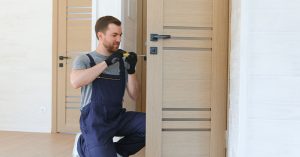Popcorn ceilings were once a popular design choice in Calgary homes. They helped cover imperfections and absorb sound. However, many homeowners now realize these textured surfaces can hide a serious problem—asbestos. We often overlook this issue until a renovation or water damage exposes the ceiling’s age and risks. Understanding what asbestos is, where it hides, and how to handle it safely helps prevent exposure and protect your home.
Why Popcorn Ceilings Contain Asbestos
Popcorn ceilings became common in homes built between the 1950s and 1980s. During that time, asbestos was added to ceiling texture materials because it improved durability and fire resistance. These ceilings were sprayed or painted with a mix that included asbestos fibers, giving them their rough, bumpy finish. The material was cost effective and easy to apply, so builders used it widely in houses, apartments, and offices across Calgary.
As long as the surface stays undamaged, asbestos fibers remain sealed within the texture. The real danger starts when the material is disturbed. Drilling, sanding, or scraping a popcorn ceiling releases tiny asbestos fibers into the air. Once inhaled, these fibers can cause long term health issues. Many homeowners only learn about the hazard after starting a renovation project, which is why testing before any work begins is essential.
Identifying Popcorn Ceilings That Might Contain Asbestos
Not every textured ceiling contains asbestos, but age and building history offer clues. Homes built before 1990 are more likely to have asbestos materials. In Calgary, many properties from this period still have the original ceilings untouched. If you are unsure about your home’s age or renovation history, assume the texture may contain asbestos until tested.
Visually, it is almost impossible to confirm asbestos presence by sight alone. Some ceilings with similar textures contain harmless materials. The safest approach is professional testing. A sample taken correctly and analyzed by a certified lab gives accurate results. Homeowners should never scrape or collect samples without protection, as doing so can release dangerous fibers into the air.
If your home falls within that age range and the ceiling looks rough, bubbly, or uneven, it is best to pause any renovation until the area is tested. Even simple actions like changing light fixtures or cutting holes for wiring can release asbestos if the ceiling is disturbed.
Health Risks Linked to Asbestos Exposure
Asbestos exposure does not cause immediate symptoms, which makes it especially dangerous. Over time, inhaled fibers can build up in the lungs, causing inflammation and scarring. Prolonged exposure increases the risk of diseases like asbestosis, lung cancer, and mesothelioma. These conditions often appear decades after the initial contact, making prevention the only reliable form of protection.
Short term exposure from a single incident may seem harmless, but repeated or high levels of dust increase risks. Family members, including children and pets, can also be affected if asbestos dust spreads through the air or HVAC system. Because these fibers are microscopic, standard cleaning does not remove them. Once airborne, they stay suspended for hours and easily spread throughout a home.
For this reason, even small popcorn ceiling repairs should be handled carefully. We recommend professional inspection and removal instead of do it yourself methods that might make the problem worse. It is always safer to know for sure before starting any ceiling work.
Testing Popcorn Ceilings Safely
Testing is the first and most important step in confirming asbestos presence. In Calgary, several certified environmental testing services provide accurate assessments. During the test, a small section of the ceiling texture is collected using protective gear and containment procedures. The sample is sealed and sent to a laboratory for microscopic analysis. Results typically come back within a few days.
Professional testing is affordable and avoids unnecessary exposure. Some homeowners attempt DIY testing kits, but improper handling can spread fibers. Certified inspectors use vacuum systems and safety protocols to prevent contamination. They can also check other materials like drywall compound, flooring adhesive, or insulation, which sometimes contain asbestos too.
If your test confirms asbestos, you do not need to panic. Many homes have small areas that can remain safely undisturbed. However, if you plan to renovate, sell, or repair water damage, removal becomes necessary. When that time comes, finding a qualified team that handles asbestos removal Calgary ensures the job is done safely and meets provincial standards.
When and Why Asbestos Removal Becomes Necessary
Leaving an undamaged ceiling alone may be acceptable in some cases. Yet, once the material starts cracking, peeling, or breaking apart, removal becomes the only safe option. Moisture damage from roof leaks or humidity can also weaken ceiling texture, making fibers easier to release.
If you plan to replace lighting, install ceiling fans, or change insulation, asbestos removal should happen before any construction work. Professional teams use containment barriers, negative air systems, and specialized vacuums to ensure dust does not spread. They follow strict disposal procedures required by Alberta regulations.
Homeowners sometimes think painting or sealing an old popcorn ceiling will trap the fibers. However, this is only a temporary measure. If the surface is ever sanded or drilled later, the fibers become airborne again. Proper removal eliminates that risk entirely, allowing safe renovations in the future.
What to Expect During Professional Asbestos Removal
Once testing confirms asbestos, certified contractors create a removal plan. The area is sealed off with plastic sheeting and negative air pressure equipment. Workers wear protective suits and respirators. They wet the ceiling material to prevent dust, carefully scrape it off, and place it in sealed containers for disposal.
The process may take several hours or days depending on the room size and texture thickness. After removal, air quality tests confirm that fiber levels are safe before cleanup begins. This thorough approach keeps your living space safe and ensures compliance with environmental standards.
Afterward, homeowners often choose a smooth drywall finish or a new modern texture. The removal team typically provides guidance on re painting or re finishing options once the area is completely safe.
Long Term Safety and Prevention
Once asbestos is removed, prevention means maintaining awareness in other parts of the home. Some older walls, insulation, and flooring may still contain asbestos materials. Regular maintenance checks during renovations or property purchases can prevent unexpected exposure later.
Keeping copies of testing and removal reports is also valuable. These records help future buyers and contractors understand what work was done and which materials are safe. Homeowners planning future projects should always share these details to avoid unnecessary repeat testing.
If you suspect any other part of your home might contain asbestos, it is best to schedule an inspection before starting work. Contacting a local professional team through contact us ensures your questions are answered and your options are clear. Professional advice helps plan repairs or renovations safely and efficiently.
Cost and Practical Considerations
Asbestos testing and removal costs depend on several factors including ceiling size, contamination level, and accessibility. In Calgary, most testing services offer clear pricing based on square footage. Removal costs rise when ceilings cover multiple rooms or require complex containment setups.
Although it may seem like a significant expense, removal protects long term health and increases property value. Homes without asbestos are safer and easier to sell. In many cases, insurance policies may assist with costs if removal is part of necessary damage repair. It is always best to confirm coverage before starting the process.
Trying to remove asbestos without professional help often ends up costing more due to contamination cleanup and potential fines. Following proper procedures from the start saves both time and money.
Common Misconceptions About Asbestos
Many homeowners believe asbestos only affects older commercial buildings, but residential use was widespread. Another misconception is that small repairs are harmless. Even minor sanding or drilling can release fibers. Some also think that visible dust means danger, yet asbestos particles are invisible.
Others assume wearing a mask or using a shop vacuum provides enough protection. Standard masks cannot filter asbestos fibers, and vacuums without HEPA filters spread them further. Understanding these misconceptions prevents risky shortcuts. Safe handling requires certified equipment and proper disposal.
Awareness remains the best defense. Knowing when to call professionals and avoiding disturbance until testing confirms safety can prevent unnecessary exposure.
FAQs
1. How can I tell if my popcorn ceiling has asbestos?
You cannot tell by looking. The only reliable method is lab testing. A certified professional collects a small sample safely and sends it for analysis.
2. Is it safe to live in a home with asbestos popcorn ceilings?
If the ceiling is in good condition and undisturbed, it is usually safe. The risk increases when the material is damaged or handled without protection.
3. Can I remove asbestos myself?
It is strongly discouraged. Removing asbestos without certification can release dangerous fibers and cause contamination. Professional removal is the safest option.
4. How long does asbestos removal take?
Removal time depends on ceiling size and contamination level. Most residential jobs take one to three days, including air quality testing afterward.
5. What should I do if I find damaged popcorn texture?
Avoid touching or cleaning the area. Close off the room and contact a certified asbestos professional for assessment and testing immediately.



